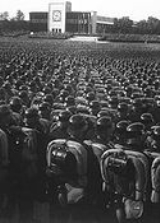
—including all of the great power
s—eventually forming two opposing military alliances: the Allies
and the Axis
. It was the most widespread war in history, with more than 100 million military personnel mobilised. In a state of "total war
", the major participants placed their entire economic, industrial, and scientific capabilities at the service of the war effort, erasing the distinction between civilian and military resources.
1936 World War II (Prelude to): In violation of the Locarno Pact and the Treaty of Versailles, Germany reoccupies the Rhineland.
1937 Chinese Air Force Day: The beginning of air-to-air combat of the Second Sino-Japanese War and World War II in general, when 6 Imperial Japanese Mitsubishi G3M bombers are shot down by the Nationalist Chinese Air Force while raiding Chinese air bases.
1939 World War II: Germany takes Memel from Lithuania.
1939 World War II: Italy invades Albania.
1939 World War II: Germany and Italy sign the Pact of Steel.
1939 World War II: Germany and the Soviet Union sign a non-aggression treaty, the Molotov-Ribbentrop Pact. In a secret addition to the pact, the Baltic states, Finland, Romania, and Poland are divided between the two nations.
1939 World War II: Nazi Germany invades Poland, beginning the war in Europe.
1939 World War II: following the start of the invasion of Poland the previous day, the Free City of Danzig (now Gdańsk, Poland) is annexed by Nazi Germany.
1939 World War II: France, the United Kingdom, New Zealand and Australia declare war on Germany after the invasion of Poland, forming the Allies.
1939 World War II: The Battle of Barking Creek.

